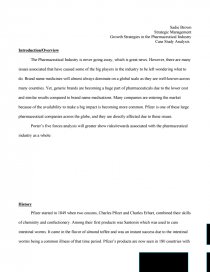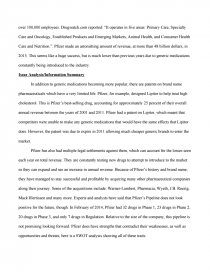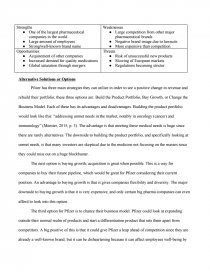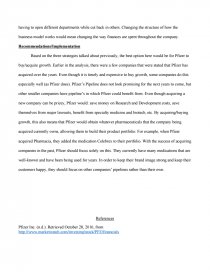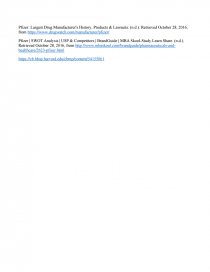Growth Strategies in the Pharmaceutical Industry - Pfizer
Essay by sadiebrown • November 13, 2016 • Case Study • 1,156 Words (5 Pages) • 2,108 Views
Essay Preview: Growth Strategies in the Pharmaceutical Industry - Pfizer
Sadie Brown
Strategic Management
Growth Strategies in the Pharmaceutical Industry
Case Study Analysis
Introduction/Overview
The Pharmaceutical Industry is never going away, which is great news. However, there are many issues associated that have caused some of the big players in the industry to be left wondering what to do. Brand name medicines will almost always dominate on a global scale as they are well-known across many countries. Yet, generic brands are becoming a huge part of pharmaceuticals due to the lower cost and similar results compared to brand name medications. Many companies are entering the market because of the availability to make a big impact is becoming more common. Pfizer is one of these large pharmaceutical companies across the globe, and they are directly affected due to these issues.
Porter’s five forces analysis will greater show risks/rewards associated with the pharmaceutical industry as a whole:[pic 1]
[pic 2]
[pic 3][pic 4][pic 5]
[pic 6][pic 7]
[pic 8]
[pic 9]
History
Pfizer started in 1849 when two cousins, Charles Pfizer and Charles Erhart, combined their skills of chemistry and confectionery. Among their first products was Santonin which was used to cure intestinal worms. It came in the flavor of almond toffee and was an instant success due to the intestinal worms being a common illness of that time period. Pfizer’s products are now seen in 180 countries with over 100,000 employees. Drugwatch.com reported: “It operates in five areas: Primary Care, Specialty Care and Oncology, Established Products and Emerging Markets, Animal Health, and Consumer Health Care and Nutrition.”. Pfizer made an astonishing amount of revenue, at more than 48 billion dollars, in 2015. This seems like a huge success, but is much lower than previous years due to generic medications constantly being introduced to the industry.
Issue Analysis/Information Summary
In addition to generic medications becoming more popular, there are patents on brand name pharmaceuticals which have a very limited life. Pfizer, for example, designed Lipitor to help treat high cholesterol. This is Pfizer’s best-selling drug, accounting for approximately 25 percent of their overall annual revenue between the years of 2001 and 2011. Pfizer had a patent on Lipitor, which meant that competitors were unable to make any generic medications that would have the same effects that Lipitor does. However, the patent was due to expire in 2011 allowing much cheaper generic brands to enter the market.
Pfizer has also had multiple legal settlements against them, which can account for the losses seen each year on total revenue. They are constantly testing new drugs to attempt to introduce to the market so they can expand and see an increase in annual revenue. Because of Pfizer’s history and brand name, they have managed to stay successful and profitable by acquiring many other pharmaceutical companies along their journey. Some of the acquisitions include: Warner-Lambert, Pharmacia, Wyeth, J.B. Roerig, Mack Illertissen and many more. Experts and analysts have said that Pfizer’s Pipeline does not look positive for the future, though. In February of 2014, Pfizer had 32 drugs in Phase 1, 23 drugs in Phase 2, 20 drugs in Phase 3, and only 7 drugs in Regulation. Relative to the size of the company, this pipeline is not promising looking forward. Pfizer does have strengths that contradict their weaknesses, as well as opportunities and threats; here is a SWOT analysis showing all of these traits:
Strengths
| Weaknesses
|
Opportunities
| Threats
|
Alternative Solutions or Options
Pfizer has three main strategies they can utilize in order to see a positive change in revenue and rebuild their portfolio; these three options are: Build the Product Portfolio, Buy Growth, or Change the Business Model. Each of these has its advantages and disadvantages. Building the product portfolio would look like this: “addressing unmet needs in the market, notably in oncology (cancer) and immunology” (Meester, 2015, p. 3). The advantage is that meeting these medical needs is huge since there are rarely alternatives. The downside to building the product portfolio, and specifically looking at unmet needs, is that many investors are skeptical due to the medicine not focusing on the masses since they could miss out on a huge blockbuster.
...
...
